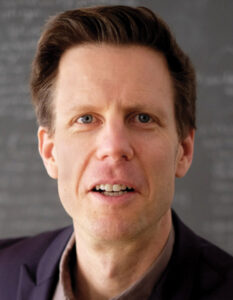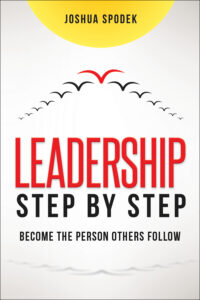Mastering Leadership Concepts
Learning how to lead. It’s the focus of many lectures, articles, blog posts, and books. Joshua Spodek prefers the active to the passive, teaching with exercises designed to master leadership concepts.
He recently wrote a book titled Leadership Step by Step: Become the Person Others Follow that takes this teaching approach. His background includes a mix of academic and corporate experience, allowing his coaching methods to incorporate the best of both. I recently spoke with him about his new book and his approach to leadership.
What Holds People Back
You bristle at the question of what qualities make someone a leader. Why?
Every book and resource lists qualities of effective leadership: integrity, self-awareness, resilience, empathy, listening skills, and so on. Popular terms now include grit and hustle.
Almost everyone knows what qualities make leaders effective. What holds people back isn’t not knowing what skills to have but how to get them and use them effectively. The techniques of nearly every book, video, MOOC, and every other resource are to teach people intellectually what they need.
But intellectually knowing that self-awareness is important doesn’t increase yours. I know the principles of playing piano. But I haven’t practiced, so I can’t play. Those least self-aware know least what to do about it, despite needing it most. The same goes for any social or emotional leadership quality.
You can’t lecture someone into integrity. No amount of reading will develop grit.
To develop social and emotional skills, you need to take on social and emotional challenges. Lectures, case studies, biography, and psychology papers may be intellectually challenging, but they are socially and emotionally passive and therefore ineffective at teaching social and emotional skills.
Learn How to Lead
Is that what you mean when you say that business school taught you about leadership but not how to lead?
Exactly. Business school taught me principles but gave me little practice using them. Discussing a case study of someone else’s life will teach you something. I’m not saying lectures and case studies are worthless, but they can’t substitute for facing personal challenges.
After graduation, I learned leadership skills in practice, but I doubt it was any faster than had I not learned the principles.
Going to a top-5 school didn’t help. The more elite the school, the more the professors got there through publishing or perishing, not facing social and emotional challenges.
So what’s the alternative? Skipping school?
I struggled with that question, especially after noticing how many great leaders dropped out or were kicked out of school: Richard Branson, Bill Gates, Oprah Winfrey, Sean Combs, Michael Dell, Elon Musk, … the list goes on.
Two observations resolved the situation for me: How you learn is as important as what you learn.
The first was seeing how many top actors had tremendous emotional and social skills, coming off as tremendously genuine and authentic, yet dropped out of school, often high school. I learned that they didn’t stop learning. They switched to a different style of learning.
The other was connecting with the project-based learning and teaching community. I found that their students developed leadership skills that MBAs would dream of, but without taking leadership classes.
How does that play out in practice?
I learned that experiential, active learning is more effective for fields like leadership that are active, social, emotional, expressive, and performance-based. Plenty of fields are like that besides leadership and acting: playing musical instruments, athletics, dance, singing, improv, the military.
In all of them we teach through practice and rehearsal. When you master the basics, you move to intermediate skills. When you master them, you move to advanced.
Only with leadership do we start with theory. Compare the quality of athletes and musicians our nation creates with the quality of our leaders, or rather people with authority.
That’s why so many great leaders emerge from sports, acting, the military, and places outside academia. Look at your page on leadership insights, https://www.skipprichard.com/leadership-insights: the first people I see are baseball player R. A. Dickey, athlete/actor Chuck Norris, and basketball player Bill Bradley.
Try a New Approach
Can you clarify how you teach if not traditionally?
I teach and coach by giving students and clients an integrated, comprehensive progression of exercises starting with basics and leading, with no big anxiety-causing jumps, to skills so useful and advanced that most seasoned leaders would learn from them.
The exercises have you do things with people you know on projects you care about, so you face social and emotional challenges, but in safe contexts, so you don’t risk your job to develop the skills. It’s like practicing piano alone, then doing small recitals, and so on to get to Carnegie Hall.
My exercises are like scales in piano or footwork in dance. Basics are valuable at every level. Look at the top seeds at Wimbledon before finals. They practice their ground strokes. LeBron still practices layups and jump shots.
I call how I teach Method Learning, after Method Acting, which is what we call the style of learning and practice for acting, and it produces Method Leaders. It’s not just acting. All the fields I listed above use the same technique.
You develop greatness, genuineness, and authenticity the same in leadership as in any of these other fields: Practice, practice, practice!
My book has stop signs after each exercise description saying, “Put the book down. Go practice. Reading about lifting weights doesn’t make you strong.”
Then what’s the role of a teacher or coach for a leader?
The teacher or coach should know the theory and should have experience. He or she uses theory and experience to create the exercises and fit them together, as well as to help the aspiring leader.
Your trainer should know anatomy. At the beginning, you don’t have to. You’ll learn it by training better than if he or she lectured it at you, assuming he or she gives you effective exercises.
Nothing replaces experience. What you can learn in a decade of trial and error, my book will give you in weeks, more comprehensively and less painfully. The online course is more comprehensive, mainly because the online forum and multimedia make learning a richer community experience, but the book has all the exercises.
Practice the Basics
Is it possible to increase empathy?
Yes, I see students do it in every course. It comes from creating exercises that are effective combined with diligent, disciplined practice and rehearsal. It’s the same in all these other fields. No matter how wooden an actor seems at first or how little expression a violinist puts into his or her playing at first, with enough practicing and rehearsing effective exercises, they’ll play with feeling. In other words, they’ll develop social and emotional skills.
Everyone who played in Carnegie Hall or the Super Bowl got there the same way: practicing the basics. Even Meryl Streep sounds unrehearsed the first time she plays a new role. She has to practice.
So you’re talking about a new approach to teaching and learning leadership?
Well, new to leadership, but longstanding in other fields. I’ve also developed and tested my exercises and courses with hundreds of students at New York University and Columbia, as well as with clients from start-ups through to the C-suites of publicly traded companies.
Thank you for sharing this new, old perspective. Any last words of advice?
Practice, practice, practice!
For more information, see: Leadership Step by Step


